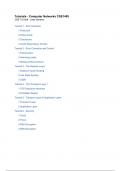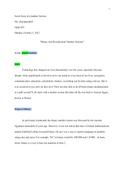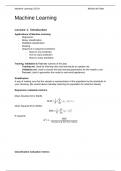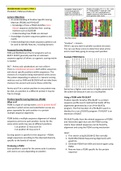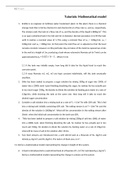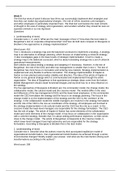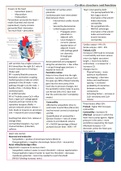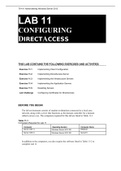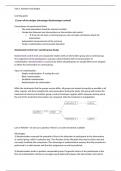Tutorials - Computer Networks CSE1405
CSE TU Delft - Lieke Sanders
Tutorial 1 - Error Detection
1 Parity bits
2 Parity words
3 Checksums
4 Cyclic Redundancy Checks
Tutorial 2 - Error Correction and Control
1 Parity blocks
2 Hamming codes
3 Sliding window protocol
Tutorial 3 - The Network Layer
1 Distance Vector Routing
2 Link State Routing
3 CIDR
Tutorial 4 - The Transport Layer 1
1 TCP Sequence Numbers
2 Forbidden Region
Tutorial 5 - Transport Layer & Application Layer
1 Transport Layer
2 Application Layer
Tutorial 6 - Security
1 S-box
2 P-box
3 RSA Encryption
4 RSA Decryption
,Tutorial 1 - Error Detection
1 Parity bits
1.1 The following bit strings are received messages with a parity bit added. Assuming an
even parity, which of them are guaranteed to be wrong?
Method 1 - Check if number of 1s in received messages is even
Method 2 - Consider message without parity bit, compute parity bit, and check if it fits
1.2 In the previous question, you detected an error with one or more messages. Can you (as
a receiver) determine the correct version of these message(s)?
No, parity checks only detect errors but cannot correct them since we don’t know where the
error occurred
1.3 In the first question, we saw that the parity bit method could not detect an error with
some messages. Can we be sure that these messages were correctly transmitted?
No, we cannot be 100% sure. Parity bits with even parity cannot detect errors that flip an
even number of bits. For example, if the sent bit stream is 1111 0000 0000(2) and the
received bit stream is 1111 1111 1111(2), the error is not detected because of the even
number of bit flips (8 of them)
, 2 Parity words
A sender and receiver communicate by a protocol which uses parity words for error
detection. Both know that the data block is a 6 × 8 matrix and the protocol uses even parity.
The receiver receives the following message:
a Does the receiver find any error?
Add the columns together and look at the parity
No, the receiver can not find an error
b Did the receiver receive the bit sequence correctly?
The receiver cannot be sure about the correctness of the bit sequence. For example, the bits
shown in squares may have been flipped
CSE TU Delft - Lieke Sanders
Tutorial 1 - Error Detection
1 Parity bits
2 Parity words
3 Checksums
4 Cyclic Redundancy Checks
Tutorial 2 - Error Correction and Control
1 Parity blocks
2 Hamming codes
3 Sliding window protocol
Tutorial 3 - The Network Layer
1 Distance Vector Routing
2 Link State Routing
3 CIDR
Tutorial 4 - The Transport Layer 1
1 TCP Sequence Numbers
2 Forbidden Region
Tutorial 5 - Transport Layer & Application Layer
1 Transport Layer
2 Application Layer
Tutorial 6 - Security
1 S-box
2 P-box
3 RSA Encryption
4 RSA Decryption
,Tutorial 1 - Error Detection
1 Parity bits
1.1 The following bit strings are received messages with a parity bit added. Assuming an
even parity, which of them are guaranteed to be wrong?
Method 1 - Check if number of 1s in received messages is even
Method 2 - Consider message without parity bit, compute parity bit, and check if it fits
1.2 In the previous question, you detected an error with one or more messages. Can you (as
a receiver) determine the correct version of these message(s)?
No, parity checks only detect errors but cannot correct them since we don’t know where the
error occurred
1.3 In the first question, we saw that the parity bit method could not detect an error with
some messages. Can we be sure that these messages were correctly transmitted?
No, we cannot be 100% sure. Parity bits with even parity cannot detect errors that flip an
even number of bits. For example, if the sent bit stream is 1111 0000 0000(2) and the
received bit stream is 1111 1111 1111(2), the error is not detected because of the even
number of bit flips (8 of them)
, 2 Parity words
A sender and receiver communicate by a protocol which uses parity words for error
detection. Both know that the data block is a 6 × 8 matrix and the protocol uses even parity.
The receiver receives the following message:
a Does the receiver find any error?
Add the columns together and look at the parity
No, the receiver can not find an error
b Did the receiver receive the bit sequence correctly?
The receiver cannot be sure about the correctness of the bit sequence. For example, the bits
shown in squares may have been flipped

